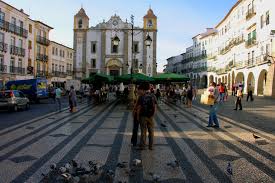🇵🇹 Exploring Évora: Portugal’s Timeless City of History, Culture, and Charm
✨ SEO Opening Keywords:
Evora tourism, historic cities in Portugal, travel to Alentejo, Roman ruins Portugal, cultural travel Portugal, UNESCO World Heritage sites Portugal, things to do in Evora, best cities to visit in Portugal.
Introduction: A Journey Through Time in the Heart of Alentejo
Nestled in the sun-drenched plains of the Alentejo region, Évora is one of Portugal’s most captivating destinations. Often overshadowed by the likes of Lisbon and Porto, Évora offers an immersive journey into the country’s rich historical and cultural past, making it a hidden gem for discerning travelers. A UNESCO World Heritage Site, the city is a well-preserved open-air museum filled with Roman ruins, medieval cathedrals, cobbled streets, and whitewashed houses.
Whether you’re passionate about archaeology, architecture, gastronomy, or simply seeking a slower-paced, authentic Portuguese experience, Évora invites you to step back in time—without sacrificing modern comforts.
1. Historical Significance: From Roman Empire to Modern Times
Évora’s history stretches over two millennia. It was a prominent Roman settlement during the 1st century BC, known as Liberalitas Julia, and many of its ancient structures still stand today. The city flourished during the Moorish occupation (8th–12th centuries) and reached its zenith under Portuguese kings in the 15th century, becoming a center of learning and culture.
Key historical highlights:
-
Temple of Diana: One of the best-preserved Roman temples on the Iberian Peninsula, standing tall with its 14 Corinthian columns.
-
Évora Cathedral (Sé de Évora): A magnificent Romanesque-Gothic cathedral built between the 12th and 13th centuries, offering panoramic views from its roof.
-
Chapel of Bones (Capela dos Ossos): A haunting Baroque chapel where thousands of human skulls and bones line the walls, reminding visitors of life’s transience.
-
Aqueduct of Água de Prata: A 16th-century aqueduct that still snakes through the city, integrated into modern structures.
2. Unique Architecture and City Layout
Évora’s architectural landscape is a harmonious blend of Roman, Moorish, and Manueline (Portuguese late Gothic) styles. Walking through the city’s narrow streets, you’ll find whitewashed buildings with wrought iron balconies, intricately designed doorways, and traditional azulejos (ceramic tiles). The city center is compact, walkable, and surrounded by ancient walls that once protected the royal court.
3. Gastronomy: A Taste of Alentejo
The Alentejo region is renowned for its rich, hearty cuisine, and Évora is its culinary capital. Meals here are slow, flavorful, and rooted in tradition, with recipes passed down through generations.
Must-try dishes:
-
Açorda Alentejana: A rustic soup made with bread, garlic, cilantro, and poached eggs.
-
Migas com Carne de Porco: Fried bread crumbs with garlic and marinated pork.
-
Queijo de Évora: A salty sheep’s cheese, perfect with local bread and olives.
-
Vinho Alentejano: The region produces some of Portugal’s finest red wines. Many wineries near Évora offer tastings and vineyard tours.
4. Local Culture and Traditions
Despite its historical significance, Évora is not a museum city—it’s alive with traditions, festivals, and local pride.
-
Academic Spirit: Home to one of Portugal’s oldest universities (Universidade de Évora, founded in 1559), the city has a youthful energy.
-
Festivals: Don’t miss the annual Festa de São João, with parades, music, and folk dancing.
-
Craftsmanship: Évora is a center for cork production—Portugal being the world’s largest cork producer. Locally made cork handbags, hats, and wallets make excellent souvenirs.
5. Nature and Landscape
Located in Alentejo’s vast plains, Évora enjoys a picturesque natural setting. The landscape is dotted with olive groves, vineyards, and cork oak forests, making it perfect for leisurely drives or bike rides through the countryside.
Nearby natural and archaeological attractions include:
-
Almendres Cromlech: A megalithic stone circle older than Stonehenge, just 15km from the city.
-
Monte da Ravasqueira: A scenic estate offering wine tastings, picnics, and horse-drawn carriage rides.
6. Weather and Best Time to Visit
Évora experiences a Mediterranean climate, with hot, dry summers and mild, rainy winters.
-
Best time to visit: Spring (April–June) and Autumn (September–October), when temperatures are comfortable and crowds are minimal.
-
Summer tips: If visiting in July or August, plan sightseeing early in the morning or late afternoon to avoid the midday heat.
7. Accessibility and Travel Costs
-
Getting There: Évora is a 1.5-hour train or car ride from Lisbon. Trains run frequently from Lisbon’s Oriente Station.
-
Accommodation: From charming pousadas (historic inns) and boutique hotels to affordable guesthouses, Évora caters to all budgets.
-
Dining Prices: A full meal in a mid-range restaurant averages €15–20. Budget travelers can enjoy hearty local dishes in taverns for under €10.
8. Why Tourists Choose Évora
Évora’s appeal lies in its authenticity and depth of experience. Here are a few reasons why it continues to enchant visitors:
✅ Authentic Experience: Unlike over-commercialized tourist spots, Évora maintains its genuine Portuguese character.
✅ Compact and Walkable: The entire city center is easy to explore on foot.
✅ Photographer’s Paradise: Every street corner offers a postcard-worthy shot.
✅ Less Crowded: Avoid the heavy crowds found in larger cities like Lisbon and Porto.
✅ Perfect Day Trip or Base: Évora can be visited on a day trip from Lisbon or used as a base for exploring Alentejo.
Conclusion: Évora—The Soul of Portugal
While many flock to Portugal’s coastal cities and beach towns, Évora offers something uniquely enriching—a peaceful, historically layered, and culturally vibrant experience. It’s not just a destination; it’s a journey into the soul of Portugal. Whether you’re a history buff, a foodie, or a traveler in search of authenticity, Évora will leave you captivated and inspired.
🇵🇹 Beyond Lisbon and Porto: Discovering the Beauty of Guimarães and Aveiro
SEO Intro (Rank-Ready):
Guimarães travel guide, Aveiro tourism tips, best cities to visit in Portugal, hidden gems Portugal, cultural travel Portugal, things to do in Guimarães and Aveiro, Portuguese historical cities, Portugal’s Venice.
Introduction: A Tale of Two Cities
While Lisbon and Porto often steal the spotlight, Guimarães and Aveiro offer two of Portugal’s most distinctive travel experiences. One is the cradle of the nation, steeped in medieval history and cobblestone charm. The other is a canal-laced city, where colorful boats drift past Art Nouveau façades and salt pans shimmer under the sun.
These two cities—each with a unique character—are ideal for travelers seeking authenticity, culture, and beauty beyond the mainstream routes.
🇵🇹 Guimarães: The Birthplace of Portugal
Often referred to as the “Cradle of Portugal”, Guimarães holds a special place in the country’s soul. It was here that Afonso Henriques, Portugal’s first king, was born, and from where he began his quest for independence from the Kingdom of León.
1. Historical Significance
-
Guimarães Castle: A well-preserved medieval fortress from the 10th century, offering panoramic views and insights into Portugal’s early struggles for sovereignty.
-
Palace of the Dukes of Braganza: A majestic 15th-century palace featuring Flemish tapestries, ornate ceilings, and medieval armor.
-
Largo da Oliveira: The historic heart of the city, surrounded by Gothic churches, cafes, and local boutiques.
The entire historic center is a UNESCO World Heritage Site, reflecting the city’s preservation of medieval urban fabric.
2. Architecture and Atmosphere
Guimarães’ granite stone buildings, flower-adorned balconies, and arcaded plazas create a storybook setting. Despite its ancient roots, the city maintains a youthful spirit thanks to its university, contemporary art scene, and cultural innovation.
3. Cultural Highlights
-
Centro Cultural Vila Flor: A modern arts venue hosting concerts, theater, and exhibitions.
-
Festival Manta: A popular music festival held in September, featuring Portuguese and international artists.
-
Holy Week and Gualterianas: Celebrations filled with parades, religious processions, and traditional music.
4. Gastronomy
-
Try Tortas de Guimarães (sweet pastries with almond and pumpkin), and enjoy local specialties like bacalhau com broa (cod with corn bread) in cozy taverns.
🇵🇹 Aveiro: Portugal’s Venice with a Coastal Soul
Situated along Portugal’s Silver Coast, Aveiro is a visual delight of canals, candy-colored boats (moliceiros), and art nouveau architecture. It’s often dubbed “The Venice of Portugal,” but its atmosphere is distinctly Portuguese.
1. Canals and Boats
The city’s canals were historically used for seaweed harvesting, now repurposed into scenic waterways. A moliceiro boat ride offers the best views of Aveiro’s architecture and murals.
2. Art Nouveau and Modern Flair
Aveiro is part of the Art Nouveau European Route, with elegant buildings like the Museu Arte Nova, housed in a beautifully restored Art Nouveau house. The blend of traditional façades with contemporary public art makes walking here an artistic experience.
3. Beaches and Lagoons
-
Costa Nova: Famous for its striped colorful beach houses and clean beaches, just 15 minutes from Aveiro.
-
Praia da Barra: A relaxed seaside town with Portugal’s tallest lighthouse and ideal spots for surfing and sunbathing.
-
Ria de Aveiro Lagoon: A scenic area for kayaking, birdwatching, and eco-tours.
4. Culinary Delights
Aveiro is known for:
-
Ovos Moles de Aveiro: A soft, sweet treat made from egg yolk and sugar, protected by a thin wafer shell.
-
Seafood stews and grilled eel, often served with local Bairrada wine.
5. Local Culture and Events
-
Festa de São Gonçalinho: A quirky January festival where locals throw hard cakes (cavacas) from the chapel roof.
-
Aveiro Tech Week: A celebration of technology, digital art, and music that attracts a creative crowd.
Travel Tips for Both Cities
| Feature | Guimarães | Aveiro |
|---|---|---|
| Distance from Porto | 55 km (45 min by train) | 75 km (1 hr by train) |
| Best Time to Visit | Spring & early Fall | Summer for beaches, Spring for canals |
| Best For | History lovers, photographers, cultural travelers | Beachgoers, families, architecture enthusiasts |
| Stay Duration | 1–2 days | 1–2 days (longer with beach stay) |

